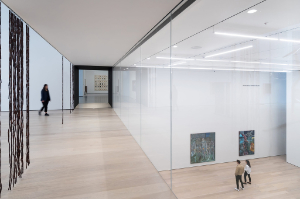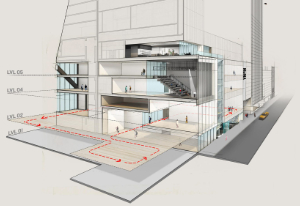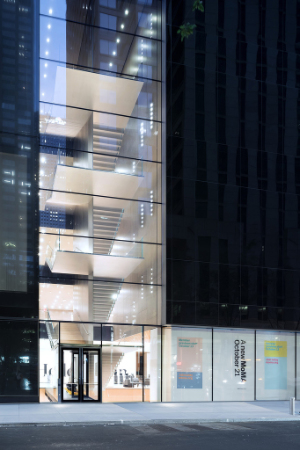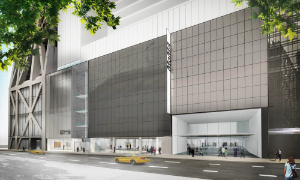 |
 |
 |
 |
 |
 |
| |
 |
|
 |
 |
 |
  |
  |
 |
 |
 |
 |
|
|
 |
|
 |
 |
 |
BUILDING |
 |
|
 |
|
 |
 |
 |
| |
 |
| 
 |
MoMA [Museum of Modern Art] - Extension
|
|
 |
 |
 |
 |
DESIGNER |
 |
|
|
 |
|
 |
 |
 |
| |
 |
|
 |
 |
 |
 |
CONTEXT |
 |
|
|
 |
|
 |
 |
 |
| Location |
 |
|
 |
|
 |
 |
 |
 |
 |
 |
 |
DESCRIPTION |
 |
|
|
 |
|
 |
 |
 |
| . |
 |
|
 |
 The expansion, developed by MoMA with architects Diller Scofidio + Renfro, in collaboration with Gensler, adds more than 40,000 square feet of gallery spaces and enables the Museum to exhibit significantly more art in new and interdisciplinary ways.
 The Studio in the heart of the Museum will feature live programming and performances that react to, question, and challenge histories of modern art and the current cultural moment. An innovative second- floor Creativity Lab for education will invite visitors to connect with art that explores new ideas about the present, past, and future. Street-level galleries, free and open to all on the expanded ground floor, will better connect the Museum to New York City and bring art closer to people on the streets of midtown Manhattan.
“Inspired by Alfred Barr’s original vision to be an experimental museum in New York, the real value of this expansion is not just more space, but space that allows us to rethink the experience of art in the Museum,” said Glenn D. Lowry, The David Rockefeller Director of The Museum of Modern Art. “We have an opportunity to re-energize and expand upon our founding mission—to welcome everyone to experience MoMA as a laboratory for the study and presentation of the art of our time, across all visual arts.” |
|
 |
 |
 |
|
 |
|
| About The Museum of Modern Art |
 |
|
 |
In the late 1920s, three progressive and influential patrons of the arts, Miss Lillie P. Bliss, Mrs. Cornelius J. Sullivan, and Mrs. John D. Rockefeller, Jr., perceived a need to challenge the conservative policies of traditional museums and to establish an institution devoted exclusively to modern art. They, along with additional original trustees A. Conger Goodyear, Paul Sachs, Frank Crowninshield, and Josephine Boardman Crane, created The Museum of Modern Art in 1929. Its founding director, Alfred H. Barr, Jr., intended the Museum to be dedicated to helping people understand and enjoy the visual arts of our time, and that it might provide New York with “the greatest museum of modern art in the world.”
The rich and varied collection of The Museum of Modern Art constitutes one of the most comprehensive and panoramic views into modern art. From an initial gift of eight prints and one drawing, The Museum of Modern Art’s collection has grown to approximately 200,000 paintings, sculptures, drawings, prints, photographs, media and performance art works, architectural models and drawings, design objects, and films. MoMA also owns approximately two million film stills. The Museum’s Library and Archives contain the leading concentration of research material on modern art in the world, and each of the curatorial departments maintains a study center available to students, scholars, and researchers. MoMA’s Library holds over 320,000 items, including books, artists’ books, periodicals, and extensive individual files on more than 90,000 artists. The Museum Archives contains primary source material related to the history of MoMA and modern and contemporary art.
The Museum maintains an active schedule of modern and contemporary art exhibitions addressing a wide range of subject matter, mediums, and time periods, highlighting significant recent developments in the visual arts and new interpretations of major artists and art historical movements. Works of art from its collection are displayed in rotating installations so that the public may regularly expect to find new works on display. Ongoing programs of classic and contemporary films range from retrospectives and historical surveys to introductions of the work of independent and experimental film- and video makers. Visitors also enjoy access to bookstores offering an assortment of publications, and a design store offering objects related to modern and contemporary art and design.
The Museum is dedicated to its role as an educational institution and provides a complete program of activities intended to assist both the general public and special segments of the community in approaching and understanding the world of modern and contemporary art. In addition to gallery talks, lectures, and symposia, the Museum offers special activities for parents, teachers, families, students, preschoolers, bilingual visitors, and people with special needs. In addition, the Museum has one of the most active publishing programs of any art museum and has published more than 2,500 editions appearing in 35 languages. |
|
 |
 |
 |
|
 |
|
| . |
 |
|
 |
|
 |
 |
 |
|
 |
|
| Museum History Timeline |
 |
|
 |
|
Museum founded and opens in the Heckscher Building at 730 Fifth Avenue
Seeking more space, the Museum moves to a five-story townhouse at 11 West 53rd Street, owned by John D. Rockefeller Jr. and Abby Aldrich Rockefeller
The newly expanded and renovated Museum, designed by Yoshio Taniguchi, opens to the public at 11 West 53rd Street, marking the Museum’s 75th anniversary year [ »link]
MoMA opens its newly expanded and renovated Museum marking the Museum’s 90th anniversary year |
|
 |
 |
 |
|
 |
|
| . |
 |
|
 |
|
 |
 |
 |
 |
 |
 |
 |
POINTS OF VIEW |
 |
|
|
 |
|
 |
 |
 |
| |
 |

“This project has called on us to work across MoMA’s rich architectural history, incorporating the Museum’s existing building blocks into a comprehensible whole through careful and deliberate interventions into previous logics, as well as the construction of new logics that arise from MoMA’s current aspirations. This work has required the curiosity of an archeologist and the skill of a surgeon. The improvements will make the visitor experience more intuitive and relieve congestion, while a new circulation network will knit together the expansion spaces with the lobbies, the theaters, and the Sculpture Garden to create a contiguous, free public realm that bridges street to street and art to city.
 The design integrates the various facets of the Museum’s architectural history, creating a distinct clear-glass façade on 53rd Street that complements the existing Goodwin and Stone, Johnson, and Taniguchi buildings and invites a more open dialogue between interior and exterior spaces.”
Glenn D. Lowry said:
“The Museum of Modern Art’s renovation and expansion project will seek to reassure and surprise. Our curators and the architectural team have spent more than two years in conversations about the nature of our collection, the history of our installations, the continually changing nature of art, and our opportunities and responsibilities for engaging our audiences. The outcome of these discussions is a design that accommodates a global view and new perspectives on modern and contemporary art, and that embodies the metabolic and self-renewing nature of our institution.” |
|
 |
 |
 |
 |
VIDEO |
 |
|
|
 |
|
 |
 |
 |
| |
 |
|
 |
 |
 |
 |
LOCATION |
 |
|
|
 |
|
 |
 |
 |

|
 |

|
Continent |
|
 |
  North America |
|
Nation |
|
 |
  United States |
|
State |
|
 |
  New York |
|
Metropolitan area |
|
 |
  New York City |
|
County |
|
 |
  New York |
|
Town |
|
 |
  New York - Manhattan |
|
Borough |
|
 |
  Manhattan |
|
Address |
|
 |
  11 West 53 Street
|
|
|
|
 |
|
Website |
|
 |
|
 |
 |
 |
 |
MAP |
 |
|
|
 |
|
 |
 |
 |
| |
 |
|
 |
 |
 |
 |
|
TYPOLOGY |
 |
|
|
 |
|
 |
 |
 |
Main |
 |
|
 |
ARCHITECTURE | Buildings for cultural activities
Art galleries and exhibition areas
Museums and buildings for exhibitions
Art museums
Operations on existing buildings
Renovation, rehabilitation and restructuring
Extension, superelevation
| |
|
|
 |
|
Additional |
 |
|
 |
ARCHITECTURE | Commercial buildings
Bars, cafeterias
Restaurants
| |
 |
 |
 |
 |
CHRONOLOGY |
 |
|
|
 |
|
 |
 |
 |
Project |
 |
|
 |
| 
 |
2014 - 2016
|
|
Realisation |
 |
|
 |
| 
 |
2016 - 2019 |
|
 |
 |
 |
 |
BIBILIOGRAPHIC REFERENCES |
 |
|
|
 |
|
 |
 |
 |
|
 |
| Edward Dimendberg, "MoMA Knows Best", Architectural Review 1405, march 2014, pp. 15, 17 |
|
|
| Kriston Capps, "Expand and Deliver", Architect 02.14, February 2014, "Front" pp. 22-23 |
|
 |
 |
 |
 |
 |
 |
 |
PHOTO+ |
 |
|
|
 |
|
 |
 |
 |
| |
 |
|
 |
 |
 |
 |
CLIENT |
 |
|
|
 |
|
 |
 |
 |
| |
 |
| MoMA Museum of Modern Art |
|
 |
 |
 |
 |
STRUCTURES |
 |
|
|
 |
|
 |
 |
 |
| |
 |
|
 |
 |
 |
 |
STAFF |
 |
|
|
 |
|
 |
 |
 |
Project  |
 |
| Diller Scofidio + Renfro (DS+R) |
|
|
 |
|
Associate designers  |
 |
|
|
 |
|
Principal-in-charge |
 |
|
Partner |
 |
| Charles Renfro, Ricardo Scofidio, Benjamin Gilmartin |
|
Project leader |
 |
| Alberto Cavallero, Zoë Small, Kevin Rice, Chris Andreacola |
|
Project architect |
 |
| Andrea Schelly, Michael Hundsnurscher |
|
Design team |
 |
| Chris Kupski, Daniel Markiewicz, Jess Austin, Mario Bastianelli |
|
Collaborators |
 |
| Lilian Fitch, David Mayner, Jonathan Parker, Sean Rowe, Heng-Choong Leong, Charles Blanchard, Fareez Giga, Sanny Ng, Derrick Benson, Ben Johnson, Roy Peer, Jason Buccheit, Chris Hall, Amber Foo, Jack Solomon, Michael Robitz, Barry Beagen, Alice Colverd |
|
Construction management |
 |
| Turner Construction Company |
|
Systems |
 |
| Jaros Baum & Bolles (JB&B) |
|
Client direction |
 |
|
Lighting design |
 |
Tillotson Design Associates [public spaces]
Renfro Design Group [gallery spaces] |
|
Facades consultant |
 |
| Heintges Consulting Architects & Engineers PC |
|
Consultants |
 |
|
Sustainability |
 |
|
Acoustical consultant |
 |
|
Theatre consultant |
 |
| Fisher Dachs Associates (FDA) |
|
Audiovisual design |
 |
| Boyce Nemec Designs [theater] |
|
Graphics and signage |
 |
|
Vertical transportation |
 |
| Van Deusen Associates (VDA) |
|
Cladding |
 |
|
Safety coordination |
 |
|
 |
 |
 |
 |
RELATED PROJECTS |
 |
|
|
 |
|
 |
 |
 |
| |
 |
|
 |
 |
 |
 |
CREDITS |
 |
|
|
 |
|
 |
 |
 |
| |
 |
Photos © Iwan Baan
Drawings © Diller Scofidio + Renfro (DS+R)
Videos © MoMA Museum of Modern Art, Diller Scofidio + Renfro (DS+R)
Text edited by MoMA Museum of Modern Art
Courtesy of MoMA Museum of Modern Art, Diller Scofidio + Renfro (DS+R)
|
|
 |
  |
 |
|
|